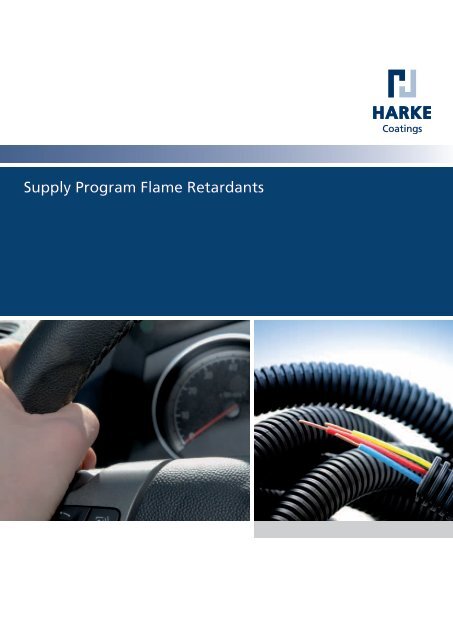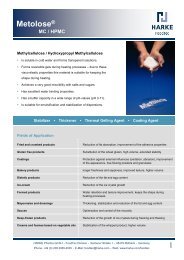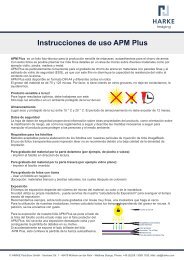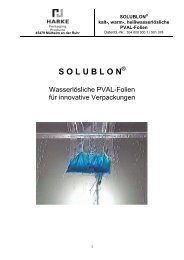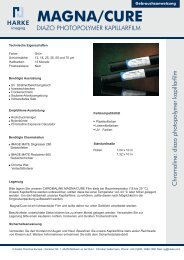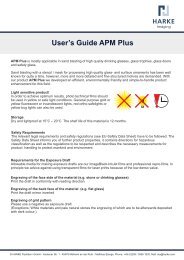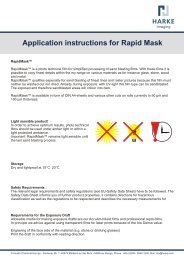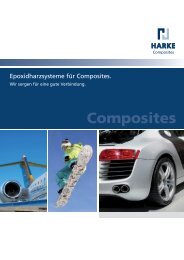Supply Program Flame Retardants - HARKE Group
Supply Program Flame Retardants - HARKE Group
Supply Program Flame Retardants - HARKE Group
You also want an ePaper? Increase the reach of your titles
YUMPU automatically turns print PDFs into web optimized ePapers that Google loves.
<strong>Supply</strong> <strong>Program</strong> <strong>Flame</strong> <strong>Retardants</strong>
Overview:<br />
<strong>Flame</strong> <strong>Retardants</strong><br />
n Chlorinated Paraffins 4<br />
n Antimony Oxide 5<br />
Intumescence-<strong>Flame</strong> <strong>Retardants</strong><br />
n Ammonium Phosphates 6<br />
n Organic Trisphosphates 7<br />
n DOPO 10<br />
<strong>HARKE</strong> Chemicals GmbH stands<br />
for certified quality and constant<br />
engagement for a sustainable<br />
protection of the environment.
Effektive Fire Protection<br />
Potential combustion sources may lurk everywhere and can ignite<br />
upholstery, cars or electronic devices. <strong>Flame</strong> retardants are used in order<br />
to make those less easily flammable. Especially plastics are easily and<br />
fast flammable, and thus these materials make high demands on fire<br />
protection. <strong>Flame</strong> retardants play an important role in the reduction of<br />
risks and spread of fire by providing time to escape, and thus property<br />
as well as environment can be protected.<br />
For each particular case the most suitable flame retardant should be<br />
used because the positive effects of fire protection may be accompanied<br />
by negative ones, as for instance the release of detrimental odors.<br />
During the last years the standards of modern flame retardants have<br />
changed. Apart from the effective fire protection also the environmental<br />
protection plays a more and more important role throughout the whole<br />
life time cycles of the products. Thus modern flame retardants should<br />
not be toxic for people, animals and plants.<br />
Benchmarking of <strong>Flame</strong> <strong>Retardants</strong><br />
Halogenated<br />
<strong>Flame</strong> <strong>Retardants</strong><br />
Intumescence-<br />
<strong>Flame</strong> <strong>Retardants</strong><br />
Place of Action Gas Phase Cond. Phase<br />
Principle of Action Chemical Chemical/<br />
Physical<br />
Performance + +<br />
Polymer Compatibility + +<br />
Side Effects Strong Smoke<br />
Development<br />
Weak Smoke<br />
Development
4<br />
<strong>Flame</strong> <strong>Retardants</strong><br />
Advantages of<br />
Cloparin ®<br />
n Boiling point at >200° C<br />
n Extremely resistant against<br />
acids and alkalis<br />
n Soluble in most organic<br />
solvents<br />
n Insoluble in water and<br />
short-chain alcohols<br />
Chlorinated Paraffins – Cloparin ®<br />
Chemical Character<br />
In the field of halogenated flame retardants we offer various types<br />
of the trade mark Cloparin ® . These chlorinated paraffins consist<br />
of chlorinated hydrocarbons, which can be produced in different<br />
chain lengths depending on their applications.<br />
Fields of Application<br />
Short-chain chlorinated paraffins are mainly applied in cooling<br />
lubricants which are used for the industrial metal production.<br />
Medium- and long-chain chlorinated paraffins are suitable as<br />
flame retardants and plasticizers for rubber products and plastics.<br />
Cloparin ® is mainly used in PVC-compounds. The different types<br />
can be used both as flame retardants and as plasticizers, and thus<br />
replace partly or even totally the conventional plasticizers.<br />
According today’s state of knowledge chlorinated paraffins are<br />
considered as environmentally dangerous materials. This especially<br />
concerns the short-chain products. The chain length ranges from<br />
C10 to C30, and the chlorine content from 20 % to 73 %.<br />
Mode of Action<br />
Similar to all halogen compounds the flame-retardant effect of<br />
chlorinated paraffins depends on their capacity as scavenger. The<br />
non-combustible hydrogen chloride is eliminated at high temperatures,<br />
and additionally chain break-up reactions disturb the combustion<br />
process and the flame expansion. In order to achieve the same<br />
flame-retardant properties as the bromine compounds, often twice<br />
the amount has to be formulated.<br />
Chlorinated paraffins decompose only at higher temperatures of<br />
>200° C, and are chemically almost inert. This means that at normal<br />
conditions they react not at all or only to an evanescently little degree<br />
with potential reaction partners, like e.g. air.
Types and Properties<br />
Our chlorinated paraffins feature various viscosities and<br />
chlorine contents whereby the right compatibility and<br />
performance is ensured for any application. They are<br />
compatible with most resins and polymers, as for instance<br />
with natural and synthetic rubber, chlorinated polyethylene,<br />
polyester, polystyrol, polyacrylate, PVC, polyvinyl acetate<br />
and chlorinated copolymers. Furthermore, our Cloparin ®<br />
types are also well mixable with other additives like<br />
phthalates, stearates and phosphates.<br />
Antimony Oxide (Sb 2 O 3 )<br />
Chemical Character<br />
Antimony oxide is a very fine, crystalline white powder<br />
having a controlled particle size. At high temperatures it<br />
stores oxygen atoms and becomes antimony tetraoxide.<br />
Fields of Application<br />
Besides the application in flame retardants antimony oxide is<br />
for instance used in plastics as a catalyst or for discoloration<br />
of glass. Moreover, it is used in enamel productionand<br />
electroplating.<br />
Mode of Action<br />
Antimony trioxide is a chemical used in flame retardants as<br />
a synergist in order to, for instance, intensify the effect of<br />
chlorinated paraffins.<br />
Properties<br />
Antimony trioxide is insoluble in water and nitric acid. It is<br />
little soluble in sulfuric acid and hydrochloric acid, whereas<br />
it, however, shows a better solubility in a concentrated<br />
solution.<br />
Cloparin ® 50 Broad application<br />
spectrum<br />
Cloparin ® 44 F Low viscosity<br />
Cloparin ® 56 Broad application<br />
spectrum<br />
Cloparin ® 49 ST Medium viscosity,<br />
high stability<br />
Cloparin ® 56 ST High viscosity<br />
and stability<br />
5
6<br />
Intumescence-<strong>Flame</strong> Retardant<br />
Ammonium Phosphates<br />
Chemical Character<br />
Ammonium phosphate is extracted from the sal ammoniac of phosphoric acid and can be used<br />
as intumescence flame retardant. In this field we offer two products, namely the acid monoammonium<br />
phosphate, also named MAP, and the alkaline diammonium phosphate, known under the<br />
acronym DAP.<br />
Fields of Application<br />
The inorganic acid phosphates are preferably used as flame retardants in cellulose material, e.g. in<br />
viscose. The inorganic alkaline phosphates are preferred as flame retardants for wood, e.g. for forest<br />
fire fighting.<br />
Mode of Action<br />
Heated and in the presence of oxygene the phosphate compounds decompose to water vapor and<br />
phosphor oxides. The latter react with the polymer matrix and dehydrate it. Thus phosphoric<br />
acid is formed, which decomposes to phosphor oxide through heat forming water vapor.<br />
Ammoniac is split into water and nitrogen and thus the retardant process is further supported.<br />
At the same time phosphor oxide forms high-melting glass-like coatings between the surface<br />
of the polymer matrix and the heat source. On the one hand these coatings cause a fast<br />
circulation of the thermal energy, and on the other hand eliminate the pocket of embers<br />
by quenching.
Types and Properties<br />
Types Characteristic Unit Typical Values<br />
Monoammonium Phosphate<br />
NH 4 H 2 PO 4<br />
Diammonium Phosphate<br />
(NH 4 ) 2 HPO 4<br />
Advantage: Broad Application Spectrum<br />
Organic Trisposphates<br />
Chemical Character<br />
Organic trisphosphates are chemical compounds of the group<br />
of phosphoric acid esters. There exists a great number of the<br />
so-called organic substituted trisphosphates that may show<br />
numerous isomers in the individual compounds.<br />
Fields of Application<br />
N % 12<br />
P 2 O 5 % 61<br />
pH (1 mol) 4<br />
Loss on Drying % 0.1<br />
Content % 99.8<br />
Insolubles % 0.01<br />
Bulk Density g/l 900<br />
Water Solubility g/l 365<br />
N % 21<br />
P 2 O 5 % 54<br />
pH (1 mol) 8.1<br />
Loss on Drying % 0.05<br />
Content % 100<br />
Insolubles % 0.01<br />
Bulk Density g/l 1000<br />
Water Solubility g/l 690<br />
Phosphor compounds are often used as flame retardants in plastics; mainly when producing soft<br />
PVC, which is used as floor covering, for manufacturing seals, cable coatings, canvasas and coatings<br />
as well as in the construction sector.<br />
Phosphoric acid compounds also unfold their retardant effect in the synthesis of caoutchouc or<br />
polyurethan elastomeres. These rigid foam plastics conduce to thermal insulation and mostly<br />
contain the low viscous trichlorisopropyl phosphate (TCPP). Diphenylcresyl phosphate (DCP) is<br />
mostly used in epoxy resins as substitute for brominated bisphenol A resins.<br />
7
8<br />
Mode of Action<br />
Phosphor compounds function in the gas phase by releasing<br />
highly effective scavengers that act as flame retardants through<br />
cutting-off the radical chain reaction. Furthermore, phosphoric<br />
acid dehydrates the polymer surface to a charred layer. This<br />
so-called carbon film prevents further feeding with oxygen, and<br />
thus impedes the advancement of the oxidate corrosion.<br />
The mechanism is especially effective with oxygenic polymers<br />
because of the combination of phosphoric acid ester with fillers<br />
like aluminium trihydrate a glassy slag is formed on the surface<br />
during fire.<br />
The organic trisphosphates can also be used in oxygen-free<br />
polymeres.<br />
The Chemical with a Double Effect<br />
When adding plasticisers as for instance diethylhexal phthalate<br />
(DEHP) the effect is that the combustibility of the plastic rises.<br />
This makes the use of flame retardants indispensable, therefore,<br />
diethylhexyl phthalate is often combined with inorganic flame<br />
retardants.<br />
Instead of using two chemicals you can change to only one.<br />
The phosphor compounds feature both the retardant effect and<br />
pasticising properties and thus counteract the brittleness of the<br />
plastic.
Types and Properties<br />
Type Formula P Content (%) Properties<br />
Diphenyl Cresyl Phosphate<br />
DCP C 19 H 17 O 4 P 9.1 DCP replaces brominated bisphenol A types<br />
in epoxy resins. In addition to that it offers<br />
plasticising properties.<br />
Triethyl Phosphate<br />
TEP C 6 H 15 O 4 P 17 TEP features two properties: In addition to its<br />
flame retardant effect it is able to lessen the<br />
viscosity of highly viscous polymeres. TEP is also<br />
used as solvent, catalyst, and ethylising reagent.<br />
Moreover, it is comparably low-priced.<br />
Tricresyl Phosphate<br />
TCP C 21 H 21 O 4 P 8.4 TCP is a flame retardant plasticiser with excellent<br />
hydrolysis stability, oil durability, super electrical<br />
isolation and a highly fungicidal effect. Principal Uses:<br />
As plasticiser and flame retardant in PVC, polyethylene,<br />
in certain leather kinds, synthetic resins and<br />
cables. Furthermore, TCP is used when formulating<br />
lubricants that have to stand high pressure or in<br />
inflammable hydraulic oils.<br />
Triphenyl Phosphate<br />
TPP C 18 H 15 O 4 P 9.5 TPP is preferred as a retardant plasticiser in<br />
cellulose compounds and synthetic rubber.<br />
It has a high flame retardant effect and very<br />
good mechanical properties. TPP is also used in<br />
paints and lacquers as well as in polyurethane<br />
high-density foams.<br />
Trioctyl Phosphate<br />
TOP C 24 H 51 O 4 P 7.1 TOP is a comparably high molecular flame<br />
retardant and plasticiser with a very low emission<br />
grade. Very low fogging.<br />
Diphenyl Octyl Phosphate<br />
DPOP C 20 H 27 O 4 P 8.6 DPO is used as flame retardant in phenol resins<br />
and PC / ABS-blends. It features very good<br />
plasticising properties.<br />
Tris (2-chloro-1methyl-ethyl) Phosphate<br />
TCPP C 9 H 18 Cl 3 O 4 P 9.5 TCPP is a plasticising flame and viscosity<br />
controlling retardant for polyurethanes.<br />
9
10<br />
DOPO<br />
Chemical Character<br />
DOPO is a halogen-free flame retardant. DOPO stands for<br />
9.10-dihydro-9-oxa-10-phosphaphenanthrene-10-oxide. It<br />
shows properties similar to the often-used brominated epoxy<br />
resins, however, without evaporation. The reason for this is that<br />
it is chemically bound to the matrix. During processing you have<br />
to keep in mind that DOPO has to be used together with multifunctional<br />
epoxy resins as for instance Novolacs because of the<br />
fact that one epoxy group reacts at a time with one molecule<br />
DOPO.<br />
Fields of Application<br />
Considering that common flame retardants evaporate, and that<br />
this may lead to a significant health risk, the general trend goes<br />
to halogen-free flame retardants.<br />
With DOPO we offer a product that features excellent flame retardant<br />
properties without evaporating harmful smells or odors.<br />
DOPO is used in epoxy resins applied in the area of computer<br />
circuit boards. Furthermore, it is always used where fire protection<br />
is necessary, but harmful smells or odors are not welcome<br />
as for instance in polyurethane, which is processed in mattresses,<br />
construction foam, foam materials or upholstery. DOPO is<br />
also used in high-power transformers on vessels, in the field of<br />
automotive and aviation industry as well as in household products.<br />
DOPO is also interesting for construction elements that<br />
are exposed to higher temperatures.<br />
Mode of Action<br />
The mode of action is based on three processes: A highly flameretardant<br />
carbon layer is formed on the surface, functioning like<br />
a protective coating and thus reducing the amount of flammable<br />
material. This process is also called “charring“.<br />
A further effect arises through intumescence. By means of induction<br />
of more gases a voluminous protection layer is formed.<br />
Thirdly, PO-radicals form through heat and take part in the<br />
radical combustion process.
Comparison of DOPO with<br />
brominated epoxy resins<br />
n Similar melting point<br />
n Same hardener types possible<br />
n Processing with the same fillers possible<br />
n Melting viscosity in similar range (125° C)<br />
n Soluble in acetone, MEK and toluene<br />
n Lighter than brominated epoxy resins<br />
n No evaporation of toxins<br />
Types and Properties<br />
P in % Blistering<br />
Features of DOPO<br />
Smoke<br />
Formation<br />
Flammability<br />
-<br />
Rating<br />
n Compliance of requirements concerning halogen-free<br />
epoxy resins in laminates<br />
n Disadvantages with respect to thermal and mechanical<br />
properties of some phosphor organic compounds are<br />
avoided<br />
n Incorporation of high glass temperature and absence<br />
of halogens if DOPO is chemically connected with the<br />
polymer matrix<br />
n Depending on how much DOPO is added, the epoxy<br />
equivalent EEW will increase from 200 to 270 - 450<br />
LOI<br />
in %<br />
Novolac / Dicy 0 Yes No V-2 24<br />
Novolac / Dicy 1.86 No No V-0 34<br />
Novolac / Dicy 3.83 No No V-0 38<br />
Novolac / DDS 0 Yes Yes V-2 23<br />
Novolac / DDS 1.69 No No V-0 27<br />
Novolac / DDS 3.63 No No V-0 33<br />
11
Get to know more in our further supply programs:<br />
n Chemicals n Composites<br />
n Coatings n Composites Rotorblades<br />
<strong>HARKE</strong> Coatings<br />
a BU of the <strong>HARKE</strong> Chemicals GmbH<br />
Xantener Straße 1<br />
45479 Muelheim an der Ruhr<br />
Germany<br />
Phone +49 (0) 208 3069-0<br />
Fax +49 (0) 208 3069-1111<br />
E-Mail chemicals@harke.com<br />
Internet www.harke.com<br />
03/11


